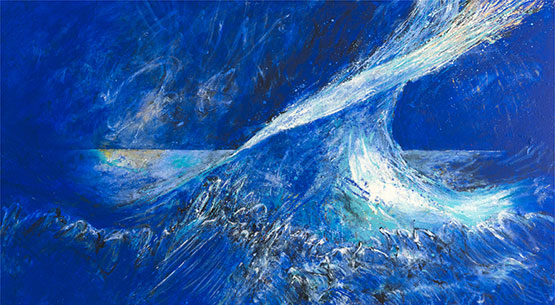Andrew Marr. Broadcaster and Author - 2017
'The Hemming & Marr Show' catalogue
Published by Mike von Joel, Project Space.
Painting is, necessarily, a solitary occupation. Everything that matters most about it takes place silently, in the brain of the painter. In the studio, when the hard work is being done, the silence is absolute.
And yet every painter needs to talk – needs help, needs criticism, needs a frank and knowing friendship. So, when I began to try to paint seriously, after I had suffered a stroke, Adrian Hemming’s friendship was both wonderful luck and a lifeline. He comes into the studio, raises a quizzical eyebrow, perhaps shakes his head about something that had pleased me, and quietly, gently, suggests other directions I might follow. And he's always right.
Adrian and I started to talk because we live close to one another, have numerous mutual friends, and do not fanatically abjure Pale Ale. But the basis of our friendship and relationship is painting, painting and painting.
I always call Adrian, with a slight note of jealousy in my voice, "a proper painter". Unlike me, he has gone through a full and rigorous training. He has devoted his entire life since teenage hood, to mastering pigment and surface, design and meaning. And, by God, it shows. Working in his Islington studio, he is meticulously picky about the colours he uses, and mostly grinds for himself. (The Unison Company of Northumberland's A19 Ultramarine being a particular favourite.) The walls around him are hung with the latest work, which is always and forever work in progress: Adrian is a great believer in the virtues of pitiless obliteration. Anything that may seem easy about his painting has been very hard won. In fact, one of the first lessons he taught me, was that even what one might consider to be a fine passage of painting - square inches one is quietly delighted with – must often be overpainted or rubbed out in the higher interests of a completed work.
This way of painting produces a surface that must be looked at near at hand. What I particularly value in Adrian's art is the rich, rucked textures, the densely worked, scored, and often extremely complex surface areas he achieves. Let me explain why I think this matters so much. We live in a world dominated by flat, glossy, glassy, screens. Today’s digital manipulation is boundless and endless. And, just as with the original invention of chemical photography in the 19th century, this technical revolution throws problems to today's painters.
How does handmade, traditional art, respond? Should we become video artists? Should we give up pencils for apps on the iPad? Both of us believe that the flatness of the digital world must send painting in the opposite direction, back to the claggy materiality, the "thisness" of oil and pigment. To be radical today is to insist on the organic essence and origins of the tradition; and I would argue that you can read this very clearly in the texture of a Hemming. (Which means that you need to look at these pictures in this show: reproductions, however good, are not nearly enough.) But – and this is not a skill I have yet achieved – Adrian’s densely worked passages occur only in harmony with larger areas of calm. The frenzy is more frenzied when surrounded by lapping, quiet, blues or greens.
Although when we talk we mainly talk about the craft and physicality of painting – about pigments, bristles, different oils and glazes – Adrian Hemming is a philosophical painter, much concerned with myth, the environment and the nature of perception. Above all he is trying to answer the most difficult and important question painters face, which is simply: "what should fresh painting look like in 2017?"

All of us who paint, paint with the huge weight of the Western tradition sitting on our shoulders. At times it can seem as if every idea has been had before. Perhaps every design, motif, colour-combination has been done better already; perhaps that all that is left even for a serious and honest painter is quotation. Adrian, like me, is fascinated and obsessive looker, a haunter of exhibitions by greats. When we flop down in our nearest pub – the Lansdowne in Gloucester Avenue – we are often talking about the latest Rauschenberg show, or Howard Hodgkin or Peter Lanyon or Patrick Heron. Adrian was taught by, among others, the painter I would regard as the most successful non-representational living British artist, Gillian Ayres. Yet he has managed that great feat: a Hemming, whatever its size, shape and colour range, looks like a Hemming and nothing else. He has absorbed, ingested and then quietly gone his own way.
I admire him so much for that. Since my stroke, I have had a much more intense sense of the importance of going your own way. Not a day passes when I don't think about how little time is left; and for me this means a redoubled effort to paint better because it is the best way of expressing my personal sense of what it means to be alive. Although this might seem a somewhat solemn undertaking, and it is certainly a strenuous one, it is in fact full of joyousness. When I am painting badly, I drive myself into a rage. But when I am painting well, I feel full of delight. A big part of that delight has come about thanks to the calm, wise friendship, and peaceable advice given to me by Adrian Hemming. A lesser man would have tried to encourage me to paint just like him: Adrian has helped me to paint like me, only better – a much harder task. As you observe these pictures, I hope you see the story of an artistic friendship too.